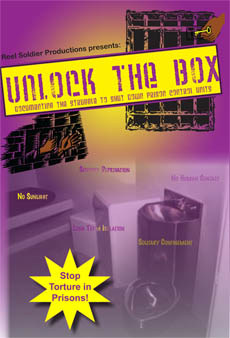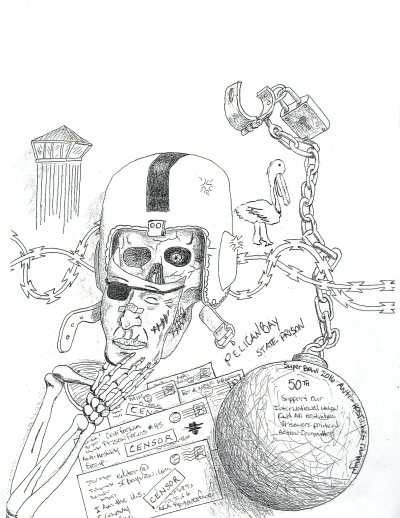
The Criminal Injustice System Works for the Jailers
It’s August 2019 and people say that the Criminal Justice System doesn’t work. I beg to differ. I’ve come to believe that it works just fine, just like slavery did as a matter of economic and political policy. How is it that a 16 year old in North Carolina who can’t get a job can suddenly generate $54,750 (which equates to $150 a day for prison upkeep) when trapped and inducted into the Criminal Injustice System where architects, food and medical providers, masons, carpenters, electricians, painters, correctional officers, administrators and a myriad other skilled trade workers get paid with guaranteed job security?
Just like the era of chattel slavery, there is a class of people dependent on the poor and on the bodies of all of us who are behind bars. All throughout the Criminal Injustice System, the policies of the police, the courts, and our prisons are a manifestation of classism, racism and dishonesty which governs the lives of all of us. Then you have prosecutors. They are like nasty little rats with quivering noses that have invaded our court systems with full impunity across the country feeding thousands of human bodies into the bowels of the razor-wire plantations without the slightest remorse for the hell they are sending us to, where slavery is mandated.
No matter how you look at it, involuntary labor is slavery. You see, the United $tates didn’t abolish slavery, they just transferred it into their prisons. So last year on 20 August 2018 with the help of outside human rights activists, prison abolitionists, anarchists, and other public supporters who did a peaceful demonstration in our prison parking lot, I, [Prisoner A], alongside [Prisoners B, C and D] all organized together with hundreds of other prisoners across North Carolina and questioned these policies by assembling peacefully and petitioning our government for a redress of our grievances.
As a result, we were all labeled as rioters and Security Threat Group individuals and sent off to super max prisons and thrown into solitary confinement where we were subjected to all sorts of mistreatment: glass was found in [Prisoner D’s] food, I was poisoned and never receiving any treatment, [Prisoner B] was sent to the Rehabilitative Diversion Unit (RDU) program where he is currently being brainwashed. [Prisoner C] got out of prison. I finally got out of solitary hell after spending 8 long months of sensory deprivation and losing 53 pounds only to face more repression and mail censorship that resulted in me receiving another 6 months for simply writing and organizing the 21 May 2019 National Grievance Day complaining about the new discriminatory JPay policy that limits who can send a prisoner money.
And what have I learned in all of this? I’ve learned that any time you restrain a person from going where they want to go, its an act of violence. Anytime you bully and mistreat someone by placing them in a cell 23 hours a day, it’s an act of violence! I’ve also learned that it’s not the inhumanity of the cruelties prisoners face in prisons on a daily basis or inhumane conditions: the cold, filth, callous medical care, tasers, unnecessary chains, pepper spray, beatings, excessive censorship, dehumanizing strip searches, extended and excessive isolation in solitary confinement for simple things like writing, or the robbing of our trust funds of $10 each time a prison guard accuses us of a rule violation that are criminalized; it’s the complaining about our conditions of confinement that’s made criminal. Right now there are tens of thousands of humans living in enforced solitary confinement cells in U.$. prisons.
Over a decade ago when news broke about what was going on in Abu Ghraib, President Bush stated “what took place in that prison doesn’t represent the America I know.” Unfortunately, for the more than 2.5 million prisoners and undocumented immigrants and the rest of us living in U.$. prisons, this is the Amerikkka we know, our family members know, and the anarchists and prison abolitionists know. Furthermore, prisoners have got to wake up and realize that the entire executive branch of the U.$. government seems to sanction torture in our prisons and all of the repression and disrespect that we endure on a daily basis from prison guards is unacceptable. It is imperative that prisoners continue to organize and to write about their experiences and complain to folks on the outside so that the public can realize what’s happening to people in U.$. prisons. There are watchdog organizations that expose, ridicule and punish Internet and school bullies and there are laws against bullying. The prison guards are also supposed to observe these laws.
The conditions and practices that men, women, and children can attest to here in North Carolina are in violation of the Universal Declaration of Human Rights, the United Nations Convention Against Torture, and the United Nations Convention on the Elimination of All Forms of Racial Discrimination. In addition, most U.$. prisons practices also violate dozens of other international treaties and clearly fit the United Nations’ definition of genocide. Aren’t you tired of being told where to sit? What to eat? Who you can socialize with inside and outside of prison? What you can watch on TV? What you may read or what you can write about or to whom? Of being denied basic dignity based on race or class? Aren’t you tired of your bodies being examined, exploited and used through dehumanizing and invasive strip-searches on the whim of a prison guard or a jailer?
Prisoners have got to continue to organize and alter the very core of every system that slavery, racism and poverty has given birth to, and particularly the Criminal Injustice System. The entire prison system must stop violating the rights of men, women, and children in North Carolina! We must effectively eliminate solitary confinement, the restriction of our civil rights, their devices of torture, family-run prisons, and all forms of sentences of “death by incarceration” or sentences that are overly burdensome, oppressive and too lengthy that financially benefit the government instead of victims of crime!
It’s plain to see that many victims could be better served by working out an honest agreement with those disingenuous persons who have wronged them, and that prosecutors have a lot of undue power to decide whom to criminalize as well as what cases are or aren’t priority. Of course these mutual agreements will not be ideal in every case, but failure to account for social context is such a crucial aspect of what’s wrong with our current system. We need to put context first and resolve each dispute in its own way rather than just applying a rigid legal formula.
I think the call for universal basic decency and respect towards all living creatures as well as towards prisoners is a powerful message that’s made more powerful when people share their stories of mistreatment. Each of our personal and individual struggles are one of many, but when we as prisoners stop focusing on the color of one’s skin, or what he or she is in prison for, and all join hands, that’s when we can get our freedoms back and that’s when we can all win.
MIM(Prisons) responds: This writer is right on when ey says that prisons do work. It’s all about understanding the real purpose of prisons. Amerikkkan prisons are not meant for rehabilitation, they are meant for social control. The author speaks of the child prisoner who is “generating” $54,750 per year. This is another purpose of prisons: distribution of profits stolen from the Third World to First World workers. All those workers in the criminal injustice system are parasites, earning good wages to further this system of social control. Those wages come mostly from state budgets. And those state budgets are just a redistribution of wealth. Imperialist wealth. Which is taken from the Third World through exploitation of workers and theft of natural resources.
This redistribution of super profits is a side “benefit” of the criminal injustice system. The focus is social control, particularly of oppressed nations. That social control wouldn’t be complete if prisoners were allowed to study, communicate and organize freely. In fact, there is a contradiction inherent in the United $tates prison system. Locking up people as a means of social control puts these people in close contact, with lots of time on their hands, which facilitates organizing and studying together. So the prisons turn to greater repression behind bars to try to stop these activities. That’s exactly what this writer is fighting against. We must demand an end to solitary confinement, an end to censorship of prisoners’ mail, and access to a real and effective grievance system. These are small goals in the context of the larger fight against imperialism. But they are goals that will bring real progress for our comrades behind bars. Progress that will allow the prisoners to organize and educate and build.








